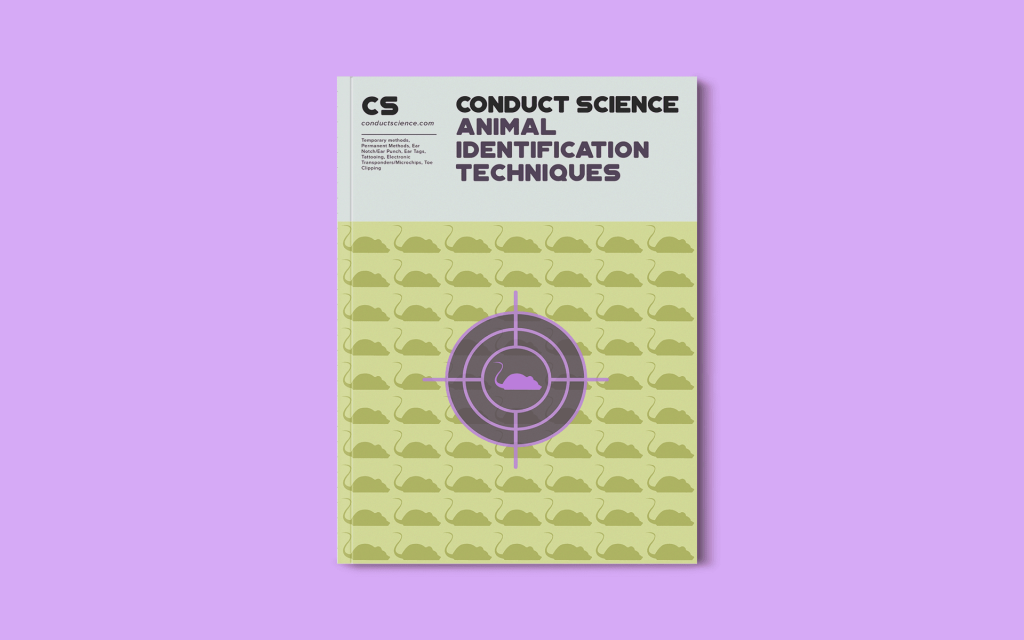

Scientific investigations, preclinical research, and pharmacological studies use a number of laboratory animals as subjects. Therefore, proper animal identification becomes a necessity. Animal identification techniques not only help keep a record of the animals but also aids communication between the healthcare professionals and researchers. Furthermore, the identification systems help experimenters comply with regulations of animal care institutions and research protocols, as animal safety and comfort are prime considerations in research involving laboratory animals.
An identification system should minimally include the researcher’s name, animal’s strain or breed, animal’s age, and source. Basic information like the above-mentioned is usually maintained on the cage cards. However, cage cards are useful when group housing is done. Whereas, when individual identification is required, ear tags, ear notch or tattoos are preferred techniques. The choice of identification method depends upon the housing type, and research protocol used. The identification method should ideally be inexpensive, permanent, and comfortable for animals and without any adverse effects. Following are the identification procedures used for laboratory animals specifically rodents.
There are some simple temporary methods to mark the animals like tail marking with pen, clipping hair, and fur dying. Pen marks last for 1-2 days while hair clipping can identify the subjects up to 14 days. The temporary nature of these methods outweighs their benefits like easy application, stress-free, and low-tech.
Ear notching or ear punching is one of the simplest animal identification techniques used for rodents. This technique is inexpensive and effortless that does not require any specific training or equipment. The only requirement of this technique is an ear puncher/notcher. There are two types of punchers available: thumb punch and scissor punch. The thumb punch is preferred in mice while the scissor punch can be used for both mice and rats.
The procedure of ear punching for animal identification is discussed as follows:
The animal is first restrained either manually or with the help of a restrainer. In rats and mice, ear pinna can be punched after two weeks of age. The site of punching is preselected and marked. The ear puncher is placed on the preselected site and quickly engaged so that a definite and firm cut can be obtained. Mostly ear punching codes range from 1-9, however, if 10-99 are to be numbered, then ‘tens’ digits are marked on the left ear while ‘ones’ digits are marked on the right ear. After safe punching, the animal is returned to its cage.
Advantages and Limitations
Ear tagging is also one of the uncomplicated and inexpensive animal identification techniques. This technique is permanent unless the tag is removed or fallen off. Labels are placed vertically at the base of the ear beyond the cartilage and in distal one-third of the pinna. Numbering on cards can range from hundreds to thousands depending upon the research or laboratory requirements.
The protocol followed for ear tagging is:
Note: Tag should not impinge the ear canal.
Advantages and Limitations
Tattooing is a permanent technique used for animal identification. Equipment for tattoos consists of a pair of micro-tattooing forceps that can hold a hypodermic syringe and needle. It can be done on body parts. However, tail and ventral paw pads are the most appropriate sites for tattooing as they ensure proper vision.
The procedure of tattooing is discussed below:
Micro-tattoo forceps are prepared with tattooing paste according to the instructions. The animal is restrained manually to avoid shaking, and then animals are anesthetized with Ketamine. With a 27-gauge hypodermic needle attached to a 1-ml tuberculin syringe, tattoo ink is injected on the pre-selected site, and the animal is marked. The animal is safely returned to its cage.
Advantages and Limitations
Subcutaneous microchips or transponders are also used for animal identification. Glass-encased passive transponders are usually employed. These microchips are biologically inert and do not need any batteries for charging. Standard subcutaneous injection of approximately 2 mm to 13 mm microchip is quick and easy. A low energy radio signal is generated by the reader that will energize the chip to transmit its code. These codes are used as identification numbers. Time is measured in milliseconds at the receiving end.
The protocol for microchips is as follows:
Advantages and Limitations
Toe clipping is the least favored technique for animal identification as it is painful and stressful for the subjects. This method requires the removal of distal phalangeal bone. The procedure followed for toe clipping is discussed as follows:
The animal is restrained with the help of anesthesia or vapor coolant. After restraining, the foot is cleansed with betadine solution. For hemostasis, the experimenter should place a sterile gauze over the site and apply pressure. The researcher should only clip one digit per extremity.
Advantages and Limitations
The primary considerations for animal identification systems are animal strains, species, housing method (group or individual), skin pigmentation, duration of the research, and type of study conducted. The identification method should ideally be durable, ethically justifiable, and bio-compatible.
Ball, D.J., Argentieri, G., Krause, R., Lipinski, M., Robinson, R.L., Stoll, R.E., and Visscher, G.E. 1991. Evaluation of a microchip implant system used for identification in rats. Lab. Anim. Sci. 41:185-186.
Fox, J.G., Anderson, L.C., Lowe, F.M., and Quimby, F.W. (eds.) 2002. Laboratory Animal Medicine. 2nd ed., pp. 179-180. Academic Press, San Diego.
Lotus Wang. 2005. A primer on rodent identification methods. Lab. Anim. Sci. 34:4.
